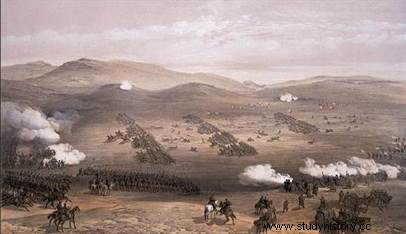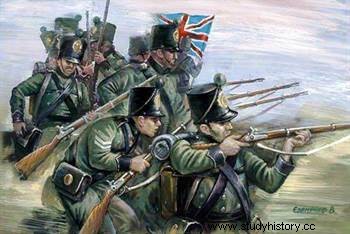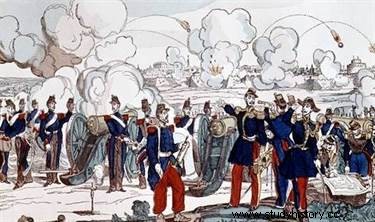 The Crimean War (1853-1856) , which opposed the Franco-British to the Russians in the Black Sea, is one of the victorious campaigns of France and fallen into oblivion because of the taboo of the Third Republic on the Second Empire . However, there remains at least in everyone's mind the famous expression "I'm there! I'll stay! », the Virgin of Puy-en-Velay and the Alma bridge which pays tribute to the fighters of the eponymous battle. A look back at this conflict, which is generally considered to be the first modern war of the 19th century , which was a turning point in European political history during the post-Napoleonic period.
The Crimean War (1853-1856) , which opposed the Franco-British to the Russians in the Black Sea, is one of the victorious campaigns of France and fallen into oblivion because of the taboo of the Third Republic on the Second Empire . However, there remains at least in everyone's mind the famous expression "I'm there! I'll stay! », the Virgin of Puy-en-Velay and the Alma bridge which pays tribute to the fighters of the eponymous battle. A look back at this conflict, which is generally considered to be the first modern war of the 19th century , which was a turning point in European political history during the post-Napoleonic period.
The causes of the Crimean War
 It is a simple quarrel over control of holy places that strains relations between the old Russian empire and the whole young French empire. The development of modern transport has multiplied the number of pilgrims to the Holy Land and the two empires are engaged in a diplomatic war to find out who, Catholics or Orthodox, will place their monks on the holiest places in Christianity under Ottoman domination. Although escalated, this politico-religious quarrel did not have enough to justify an armed conflict, and it was only a pretext on the part of the Russian Empire which considered itself aggrieved to invade Moldavia and Wallachia.
It is a simple quarrel over control of holy places that strains relations between the old Russian empire and the whole young French empire. The development of modern transport has multiplied the number of pilgrims to the Holy Land and the two empires are engaged in a diplomatic war to find out who, Catholics or Orthodox, will place their monks on the holiest places in Christianity under Ottoman domination. Although escalated, this politico-religious quarrel did not have enough to justify an armed conflict, and it was only a pretext on the part of the Russian Empire which considered itself aggrieved to invade Moldavia and Wallachia.
By this bellicose action, the Tsar officially presented himself as the great defender of the Orthodox Slavs whom he wished to unite under his domination. In fact, he invaded vassal principalities of the Ottoman Empire, forcing the latter to declare war on him on October 4, 1853. Tsar Nicolas I expects from this war the dismemberment of an already weakened Ottoman Empire and the establishment of Russians on the banks and straits of the Black Sea. Thus, the Russian fleet would have direct access to the warm seas, to the Mediterranean.
This perspective frustrates British interests who see the Russian fleet as a real danger to its sea route to India. The destruction of an Ottoman squadron by the Russian fleet at Sinop contributes to spreading the psychosis. War therefore seems inevitable, especially since the United Kingdom finds an astonishing ally:France. Indeed, while for centuries the two nations have not ceased to confront each other, here they are united by the Russian peril.
Napoleon III, emperor since 1852 only, must absolutely seek the political support of the United Kingdom, prove his good intentions. For this, and although he does not want war, a joint campaign seems a good diplomatic operation. After an ultimatum demanding the evacuation of the occupied territories, the United Kingdom and France declared war on Russia on March 27, 1854 in support of the Ottoman Empire.
Going to war
On the Danube, which the Russians refused to cross so as not to threaten Austria, the Turks constantly harassed the occupier. It was a hard war, marked by the atrocities of irregular troops such as the Maghrebi bashi-bouzouks in the service of the Ottomans.

On the Franco-British side, we are not expecting a long war. Everything suggests that the simple deployment of their forces will bring Russia to its senses. On the strength of this conviction, Napoleon III did not personally commit to this operation and entrusted the command to Marshal Armand de Saint-Arnaud. At first, the French landed in the Dardanelles and the British in Malta while waiting for supplies and the diplomatic choice of an Austria which hesitated to join the coalition.
On April 29, the Franco-British landed in Varna (Bulgaria), forcing the Russians into a strategic retreat by evacuating the Romanian provinces. As for the coalition troops, they remain in a certain immobility while waiting for the choice of Austria, which leaves time to discuss the campaign plan to be adopted... In the end, it will be the plan proposed by Napoleon III that will be retained, namely to march on the powerful naval base of Sevastopol held by the Russians in Crimea.
The Crimean War
The Franco-British landed in the Crimea in mid-September 1854 encountered on their way the Russians entrenched on the heights of the Alma River, determined to cut them off. road to Sevastopol. The shock takes place on September 14, the Foreign Legion and the other French troops go up to the attack of the Russians while the 3rd regiment of Zouaves manages to circumvent the Russians, to scale the cliffs under cover of the fire of the fleet, and to to seize the Russian guns placed on the backs! Isolated, the Zouaves turned the artillery pieces against their owners and put up a frenzied resistance.
 The brilliance of the Zouaves (hence the Zouave of the Alma bridge in Paris…) in their rear, the advance of the French, the overestimation of the number of British stretched on a thin line of two ranks, pushes the Russians to let go and abandon the ground. The Russian losses are of the order of 5,709 killed and wounded, there are 2,002 on the British side, 503 on the Ottoman side and 1,340 in the French ranks.
The brilliance of the Zouaves (hence the Zouave of the Alma bridge in Paris…) in their rear, the advance of the French, the overestimation of the number of British stretched on a thin line of two ranks, pushes the Russians to let go and abandon the ground. The Russian losses are of the order of 5,709 killed and wounded, there are 2,002 on the British side, 503 on the Ottoman side and 1,340 in the French ranks.
The Siege of Sevastopol
However, the victory is not exploited as it could have been, the Russian troops are hardly chased and can fall back as best they can on Sevastopol. The British arrive at the objective while the entrenchments are not completed, but do not attack. On the French side, Marshal Saint-Arnaud dying of cholera must entrust the command of operations to Marshal François de Canrobert. The time lost allows the Russians to entrench themselves and scuttle a few ships to block the entrance to the port. Having failed to take advantage of the blow that was the battle of Alma, the Franco-British now find themselves faced with an impregnable position that they will besiege for eleven months! The allies organize a line of defensive blockade with trenches, shelters and various positions for firing artillery. For their part the Russians use the cannons and gunners of their fleet to defend the city walls. From the start of the siege, the French ammunition depot was destroyed by the Russians, and the Russian depot destroyed by the British... The siege got bogged down, until winter brought hell to life on this little piece of Crimea. . Already victims of dysentery (due to badly smoked mutton), epidemics of scurvy and cholera, the besiegers experienced hunger and the rigors of the climate. Supplies only become regular again in the spring with the ex nihilo construction of a railway linking Balaklava to the besiegers and regularly supplying them with ammunition. For their part, the Russians are sometimes forced to shoot clay balls shaped by craftsmen to compensate for the lack of bullets. At the same time, Sardinia allied with the Franco-British and sent reinforcements. On September 8, 1855, the French general Mac-Mahon managed to seize the fortified position of Malakoff, considered essential to the capture of the city. It was on this occasion that he would have pronounced the famous “I am there! I stay there! ". Three days later, the Russians evacuate the city after destroying its fortifications.
For their part the Russians use the cannons and gunners of their fleet to defend the city walls. From the start of the siege, the French ammunition depot was destroyed by the Russians, and the Russian depot destroyed by the British... The siege got bogged down, until winter brought hell to life on this little piece of Crimea. . Already victims of dysentery (due to badly smoked mutton), epidemics of scurvy and cholera, the besiegers experienced hunger and the rigors of the climate. Supplies only become regular again in the spring with the ex nihilo construction of a railway linking Balaklava to the besiegers and regularly supplying them with ammunition. For their part, the Russians are sometimes forced to shoot clay balls shaped by craftsmen to compensate for the lack of bullets. At the same time, Sardinia allied with the Franco-British and sent reinforcements. On September 8, 1855, the French general Mac-Mahon managed to seize the fortified position of Malakoff, considered essential to the capture of the city. It was on this occasion that he would have pronounced the famous “I am there! I stay there! ". Three days later, the Russians evacuate the city after destroying its fortifications. Military operations in Crimea are coupled with the deployment of the Franco-British fleet in the Baltic Sea where a gunboat war is being waged. In addition to the technological innovations implemented on this occasion (marine mines and torpedoes), this operation mainly made it possible to fix the Russian ships and at least 30,000 men who could have helped the besieged in Sevastopol.
Congress of Paris ends Crimean War
 France having refused to extend the conflict to Poland, so as not to enter into an all-out war against Russia, peace seemed to take shape in 1855. Tsar Nicolas I died on March 2, it was his heir son Alexander II who was forced to accept the Treaty of Paris on March 30, 1856. This treaty provided, among other things, for the recognition of independence from the Ottoman Empire (interest of the British Empire) and the autonomy of the principalities of Moldavia and Wallachia, freedom of movement on the Danube (Austrian interest)… For France it is a military and diplomatic victory , the Congress of Paris of 1855 seems to erase the Congress of Vienna of 1815, the French Empire clearly reappears in the political game of the European powers.
France having refused to extend the conflict to Poland, so as not to enter into an all-out war against Russia, peace seemed to take shape in 1855. Tsar Nicolas I died on March 2, it was his heir son Alexander II who was forced to accept the Treaty of Paris on March 30, 1856. This treaty provided, among other things, for the recognition of independence from the Ottoman Empire (interest of the British Empire) and the autonomy of the principalities of Moldavia and Wallachia, freedom of movement on the Danube (Austrian interest)… For France it is a military and diplomatic victory , the Congress of Paris of 1855 seems to erase the Congress of Vienna of 1815, the French Empire clearly reappears in the political game of the European powers.
The Crimean War really appears to be one of the first modern wars with the use by the Franco-British of rifled weapons, shells, the path of iron for supplies (but also for the construction of the Virgin of Puy-en-Velay, made with the cast iron of cannons taken from the Russians), the electronic telegraph for communications, battleships, sea mines, torpedoes … It is also one of the first wars documented by photography, with photographers hired by the British government to feed the press.
Find out more
- GOUTTMAN Alain, The Crimean War 1853-1856:the first modern war, Perrin, 2003.
- The Industrial Age:Crimean War, Civil War, German Unity:1854-1871, by Brian Holden Reid. Otherwise, 2001.
